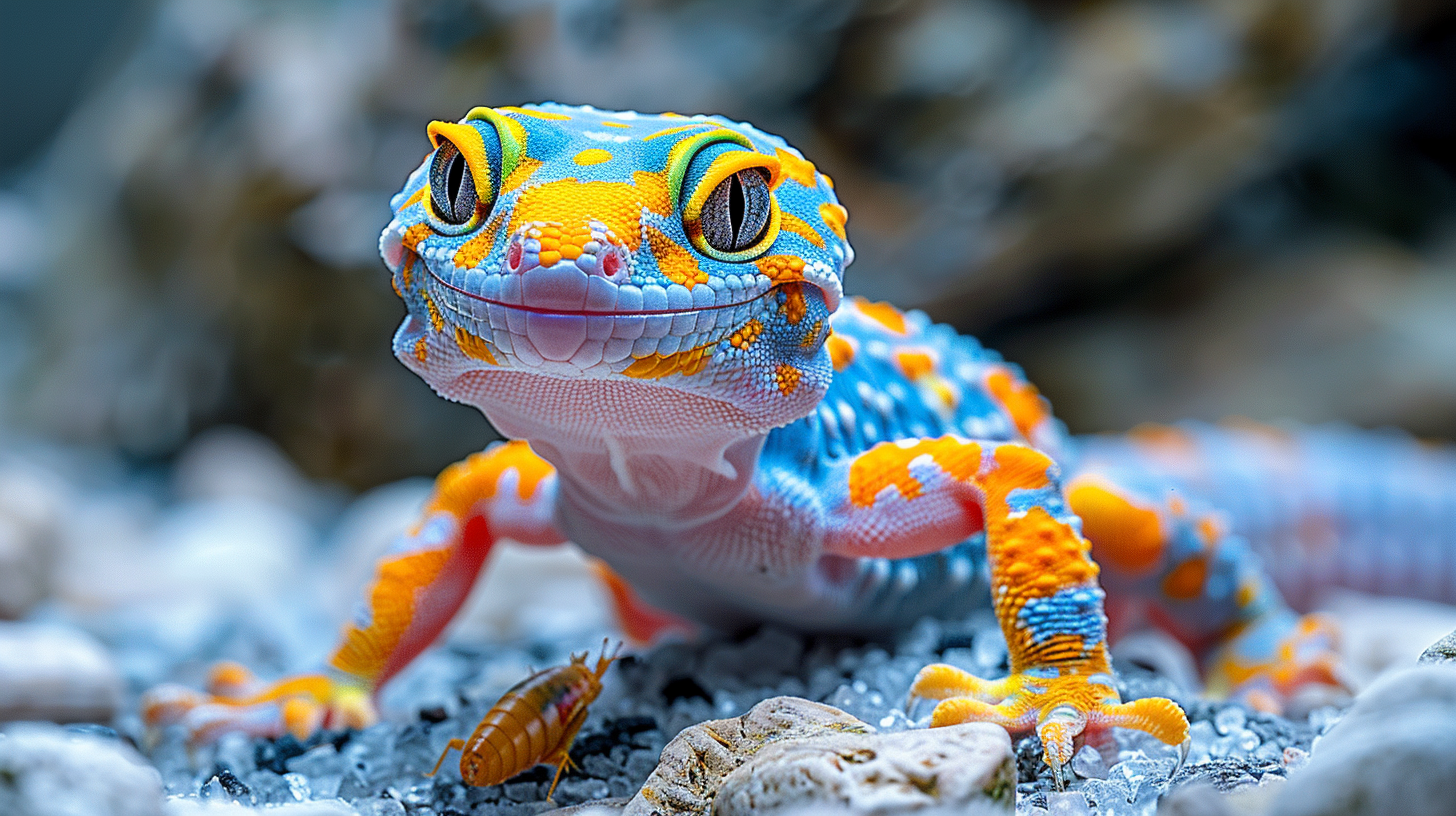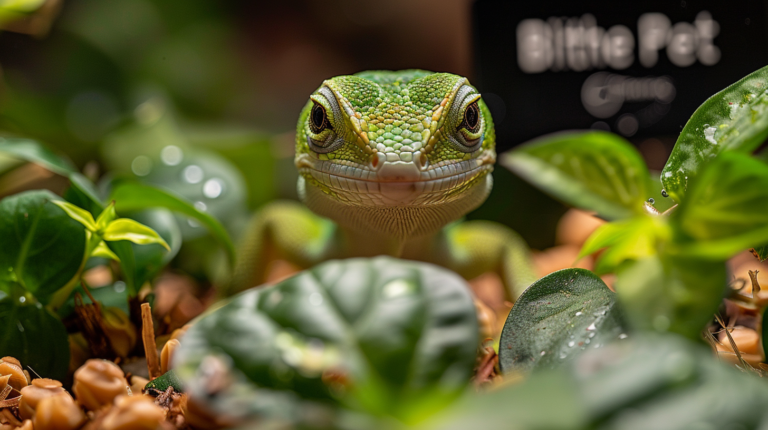Discover the best food for leopard geckos with our comprehensive guide. Learn about 10 top diet options, feeding schedules, and nutrition tips for healthy geckos.
Table of Contents
Leopard geckos have captured the hearts of reptile enthusiasts worldwide with their docile nature, stunning patterns, and relatively simple care requirements. However, one of the most critical aspects of keeping these fascinating creatures healthy and thriving is providing proper nutrition. Understanding the right food for leopard geckos is essential for their longevity, reproductive health, and overall well-being.
Unlike many reptiles that require complex dietary arrangements, leopard geckos are primarily insectivores with specific nutritional needs that must be met through carefully selected prey items. This comprehensive guide will explore the 10 best food options for leopard geckos, helping you make informed decisions about your pet’s diet while ensuring they receive optimal nutrition throughout their lifespan.
The importance of proper nutrition cannot be overstated when it comes to leopard gecko care. A well-balanced diet not only supports their physical health but also influences their behavior, reproduction, and immune system function. With the right knowledge and approach, feeding your leopard gecko can become a rewarding aspect of pet ownership that strengthens the bond between you and your scaly companion.
Understanding Leopard Gecko Nutritional Needs
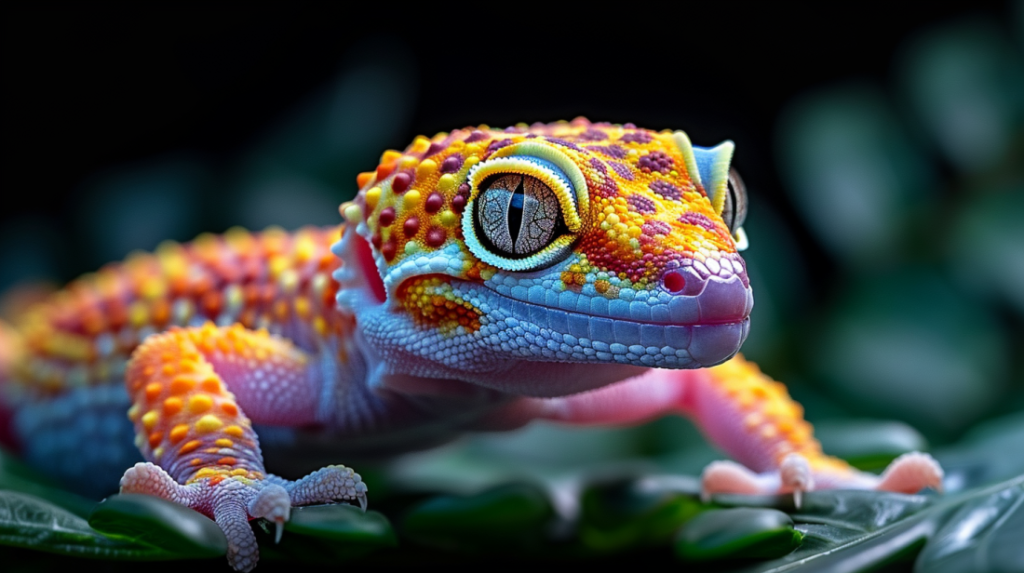
Essential Nutrients for Optimal Health
Leopard geckos require a carefully balanced combination of nutrients to maintain optimal health. Protein serves as the primary macronutrient, typically comprising 15-20% of their diet, and is essential for growth, tissue repair, and metabolic functions. High-quality protein sources from insects provide the amino acids necessary for muscle development and maintenance.
Calcium stands as perhaps the most critical mineral for leopard geckos, particularly for bone development, muscle function, and egg production in females. A calcium-to-phosphorus ratio of 2:1 is ideal, as improper ratios can lead to metabolic bone disease, a serious condition that can be fatal if left untreated. Adult geckos require approximately 0.5-1% calcium in their diet, while juveniles need slightly higher concentrations.
Vitamin D3 plays a crucial role in calcium absorption and metabolism. Unlike many reptiles, leopard geckos are crepuscular (active during dawn and dusk) and obtain most of their vitamin D3 from dietary sources rather than UVB light exposure. Fat-soluble vitamins A, D, E, and K are essential for various physiological processes, including vision, immune function, and reproduction.
Age-Specific Nutritional Requirements
Juvenile leopard geckos (0-12 months) have significantly higher nutritional demands than adults due to their rapid growth rate. They require daily feeding with appropriately sized insects, typically measuring no larger than the space between their eyes. The protein content should be higher during this growth phase, around 20-25% of their diet.
Adult leopard geckos (12+ months) can be fed every other day or every third day, depending on their activity level and body condition. Their protein requirements decrease slightly to 15-20%, but calcium and vitamin supplementation remains crucial. Breeding females require increased nutrition, particularly calcium, to support egg production and prevent calcium depletion.
Senior geckos may experience decreased appetite and metabolic changes, requiring adjustments to feeding frequency and prey size. Smaller, more frequent meals may be necessary to maintain body weight and ensure adequate nutrition absorption.
The 10 Best Food Options for Leopard Geckos
1. Crickets: The Staple Diet Foundation
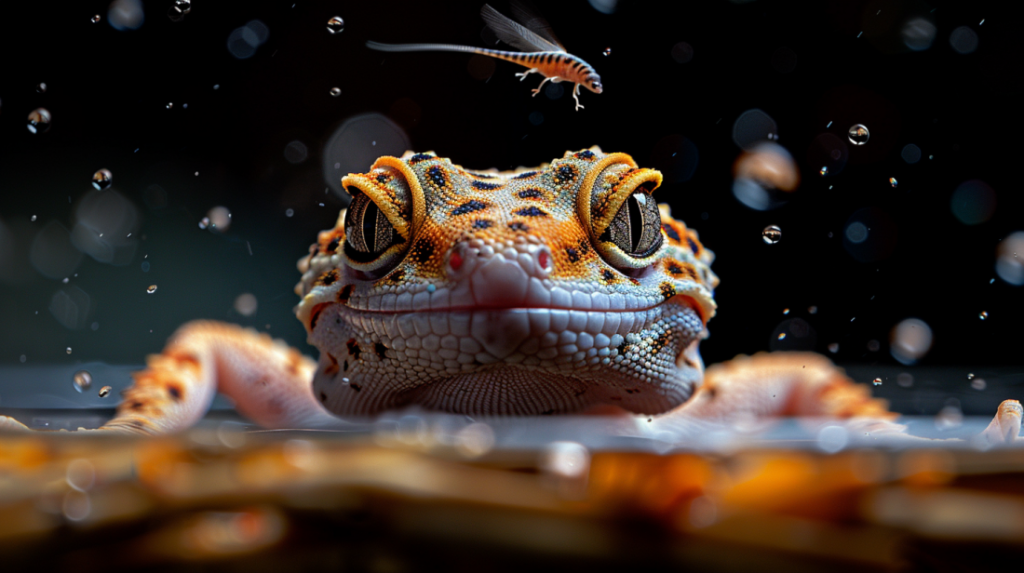
Crickets serve as the cornerstone of most leopard gecko diets, providing excellent nutritional value and natural hunting stimulation. House crickets (Acheta domesticus) contain approximately 20% protein and 6% fat, making them an ideal staple food. Their active movement triggers the gecko’s natural hunting instincts, providing mental stimulation and exercise.
When selecting crickets, choose specimens that are no larger than the space between your gecko’s eyes. Adult geckos can typically handle 1/2 to 3/4 inch crickets, while juveniles require smaller sizes. Crickets should be gut-loaded 24-48 hours before feeding to enhance their nutritional value.
The calcium-to-phosphorus ratio in crickets is approximately 1:8, which is inverted from the ideal ratio leopard geckos require. This makes calcium supplementation essential when feeding crickets as a primary food source. Dusting crickets with calcium powder before feeding helps correct this imbalance.
2. Mealworms: Convenient and Nutritious
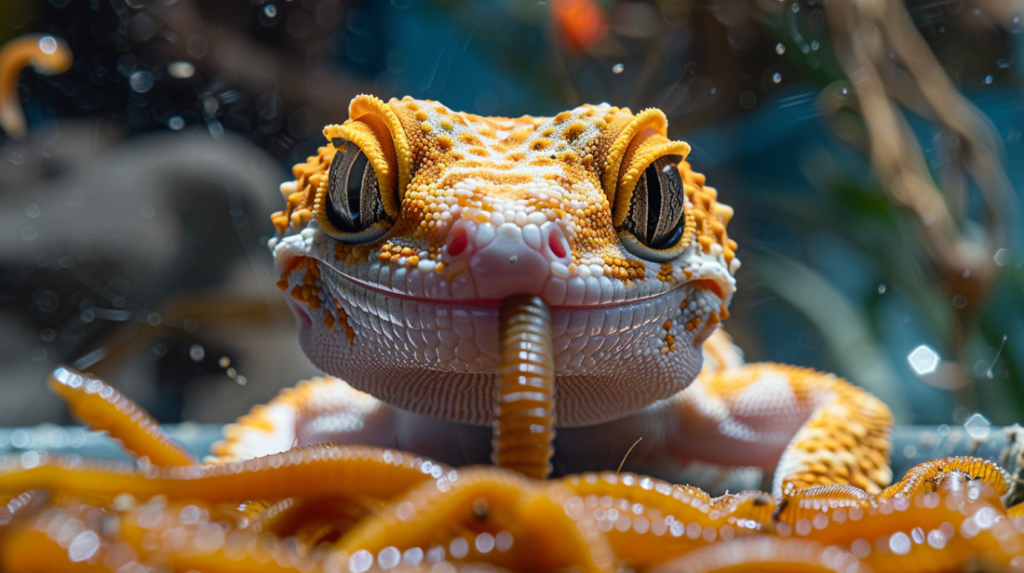
Mealworms (Tenebrio molitor) offer convenience and excellent nutrition for leopard geckos. They contain approximately 18% protein and 13% fat, providing a good energy source. Their longer shelf life and ease of storage make them popular among gecko keepers, especially those feeding single animals.
Regular mealworms are suitable for adult geckos, while mini mealworms work well for juveniles. The chitin content in mealworms can be beneficial for digestive health, but excessive feeding may cause impaction in some geckos. Limiting mealworms to 20-30% of the total diet helps prevent potential digestive issues.
Gut-loading mealworms with nutritious foods like vegetables, fruits, and commercial gut-loading diets significantly improves their nutritional profile. Store mealworms in a cool, dry place with adequate ventilation to maintain their health and nutritional value.
3. Dubia Roaches: Premium Nutrition Choice
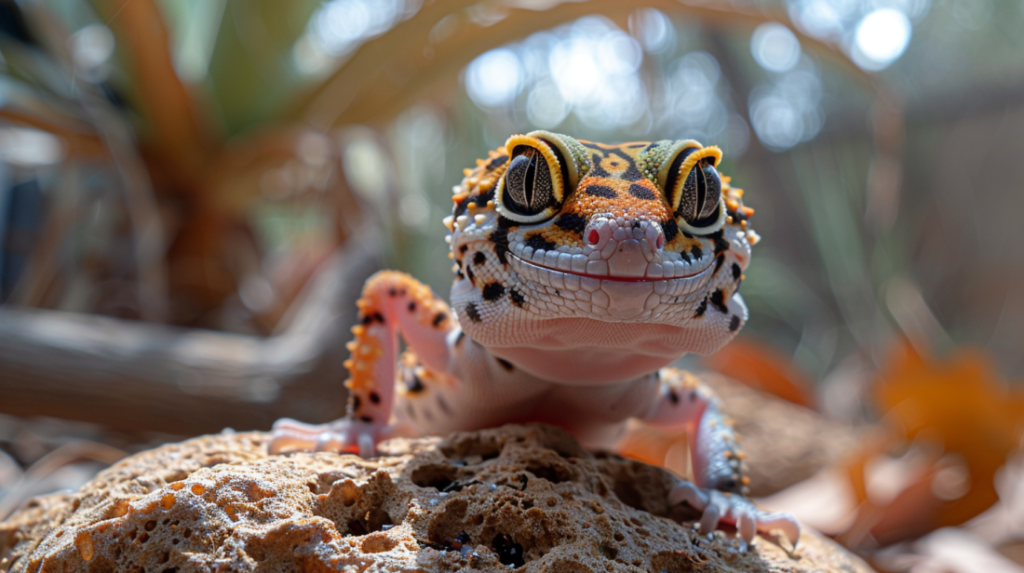
Dubia roaches (Blaptica dubia) are increasingly recognized as one of the best food for leopard geckos due to their exceptional nutritional profile. They contain approximately 23% protein and 7% fat, with a superior amino acid profile compared to many other feeder insects. Their soft exoskeleton makes them easier to digest than harder-shelled alternatives.
The calcium-to-phosphorus ratio in dubia roaches is approximately 1:3, which is significantly better than crickets, though supplementation is still necessary. They produce minimal noise and odor compared to crickets, making them more suitable for indoor keeping.
Dubia roaches are available in various sizes, from small nymphs suitable for juvenile geckos to large adults for breeding females or particularly large geckos. Their docile nature makes them easy to handle and reduces stress for both the gecko and the keeper during feeding.
4. Waxworms: Occasional High-Energy Treats
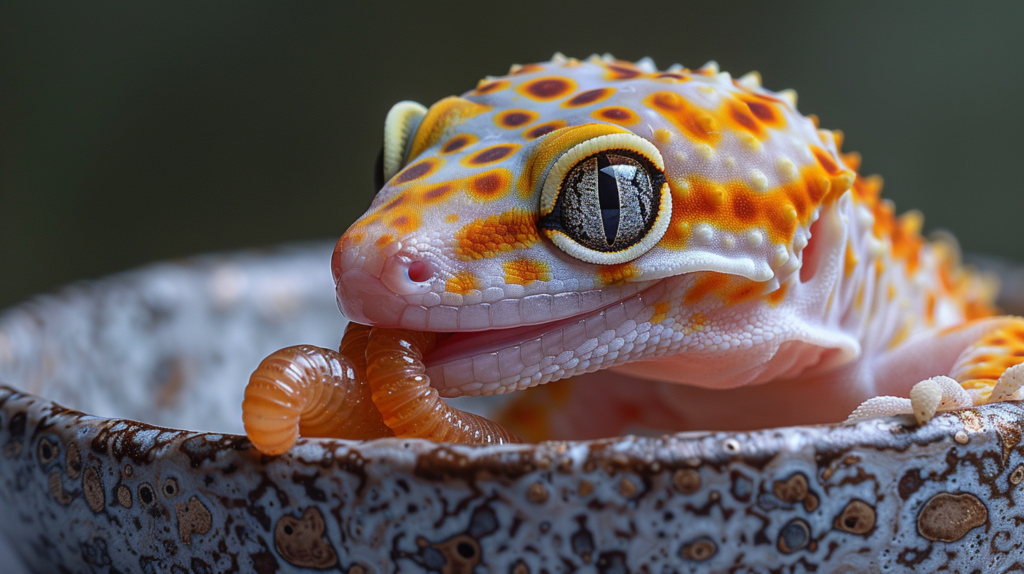
Waxworms (Galleria mellonella) should be considered treats rather than staple foods due to their high fat content (approximately 15-20%). They contain about 15% protein and are particularly useful for underweight geckos or those recovering from illness. Their soft texture makes them easy to digest and highly palatable.
The high fat content makes waxworms excellent for pregnant or breeding females who require additional energy reserves. However, overfeeding waxworms can lead to obesity and related health issues. Limiting waxworms to 10-15% of the total diet helps maintain nutritional balance.
Waxworms are particularly useful for encouraging appetite in sick or stressed geckos. Their movement and scent often trigger feeding responses even in reluctant eaters. Store waxworms in a cool environment to slow their development and maintain their nutritional value.
5. Superworms: Larger Prey Option
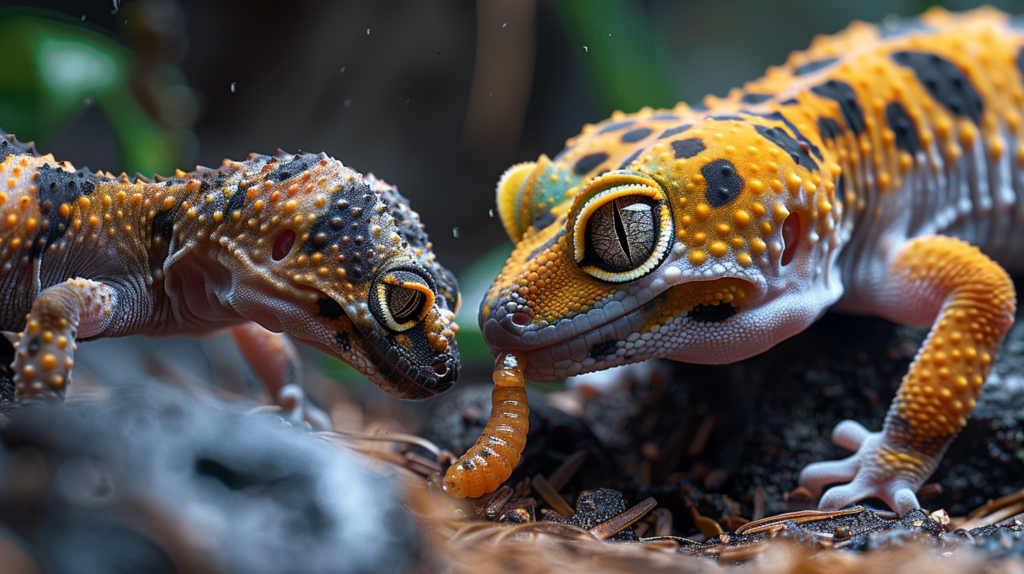
Superworms (Zophobas morio) provide an excellent option for adult leopard geckos, containing approximately 17% protein and 14% fat. Their larger size makes them suitable for adult geckos but inappropriate for juveniles due to impaction risks. The increased size also provides more substantial meals, reducing the number of individual insects needed.
The digestive process required for superworms can provide beneficial exercise for the gecko’s digestive system. However, their harder exoskeleton requires more energy to digest compared to softer alternatives. Limiting superworms to 2-3 times per week helps prevent digestive stress.
Gut-loading superworms with high-quality foods significantly improves their nutritional contribution. Their longer lifespan compared to crickets makes them convenient for keepers who prefer to purchase feeders in bulk.
6. Silkworms: Premium Soft-Bodied Option
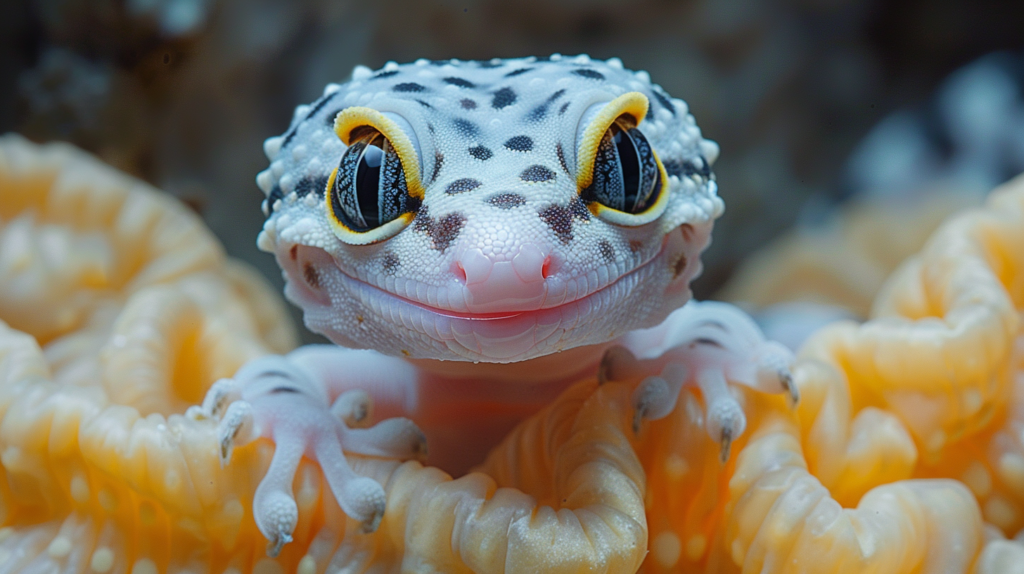
Silkworms (Bombyx mori) represent one of the most nutritious options available, containing approximately 18% protein and 4% fat. Their soft bodies make them extremely easy to digest, and they contain natural enzymes that can benefit digestive health. The amino acid profile in silkworms is considered superior to most other feeder insects.
Silkworms are particularly beneficial for sick or recovering geckos due to their easy digestibility and high nutritional value. They’re also excellent for breeding females who require high-quality nutrition for egg production. The calcium-to-phosphorus ratio is approximately 1:2, which is better than many alternatives.
The primary drawback of silkworms is their cost and limited availability. They also have a shorter shelf life than many other feeders, requiring more frequent purchasing. However, the nutritional benefits often justify the additional expense for dedicated gecko keepers.
7. Phoenix Worms (Black Soldier Fly Larvae): Calcium-Rich Choice
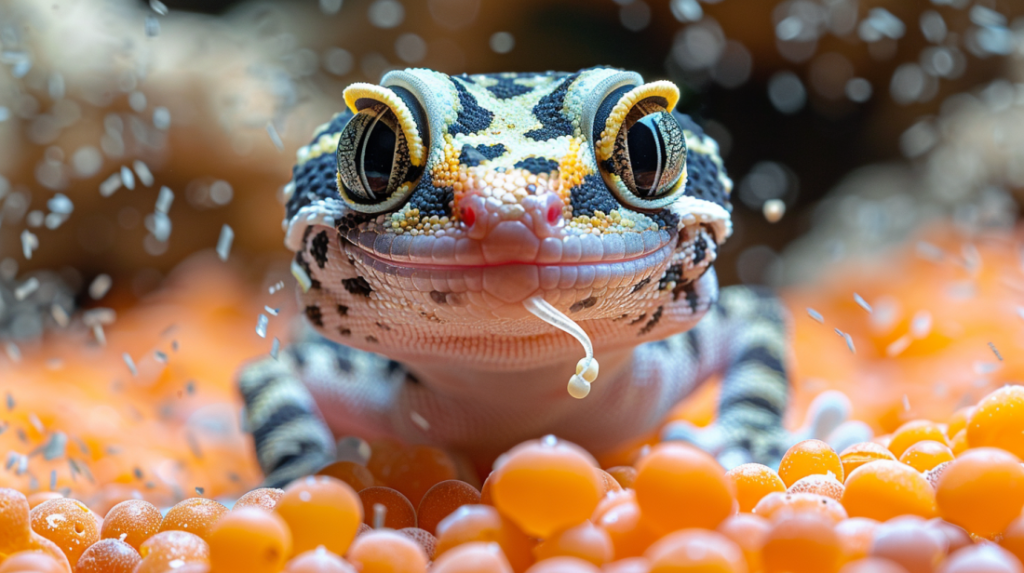
Phoenix worms, also known as black soldier fly larvae (Hermetia illucens), offer exceptional calcium content with a calcium-to-phosphorus ratio of approximately 1.5:1. This makes them one of the few feeder insects that require minimal calcium supplementation. They contain about 17% protein and 14% fat.
The high calcium content makes phoenix worms particularly valuable for growing juveniles and breeding females. Their soft exoskeleton and small size make them suitable for geckos of all ages. They also contain beneficial lauric acid, which has antimicrobial properties.
Phoenix worms can be stored at room temperature for extended periods without degrading in quality. They don’t require feeding or maintenance, making them convenient for busy gecko keepers. Their natural calcium content reduces the need for extensive supplementation.
8. Butterworms: Occasional Protein Boost
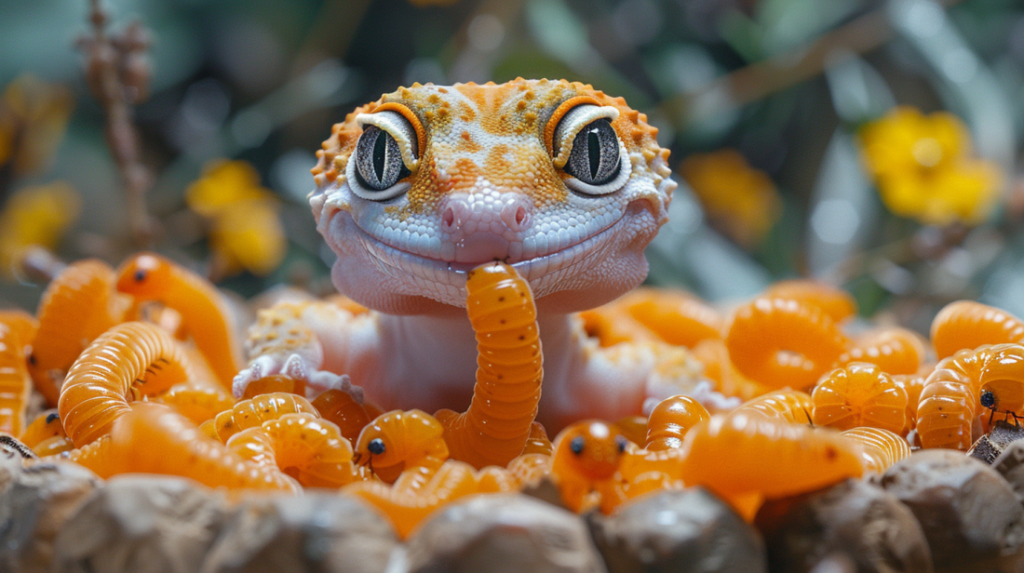
Butterworms (Chilecomadia moorei) provide a unique nutritional profile with approximately 15% protein and 29% fat. Their extremely high fat content makes them strictly treats, suitable only for underweight geckos or those requiring rapid weight gain. The protein quality is excellent, with a superior amino acid profile.
The bright orange color of butterworms comes from carotenoids, which can enhance the coloration of leopard geckos over time. However, their high fat content means they should represent no more than 5-10% of the total diet to prevent obesity and related health issues.
Butterworms are particularly useful for geckos recovering from illness or injury when rapid weight gain is beneficial. Their palatability makes them excellent for encouraging appetite in reluctant feeders. Store butterworms in a cool, dry environment to maintain their quality.
9. Hornworms: Hydrating and Nutritious
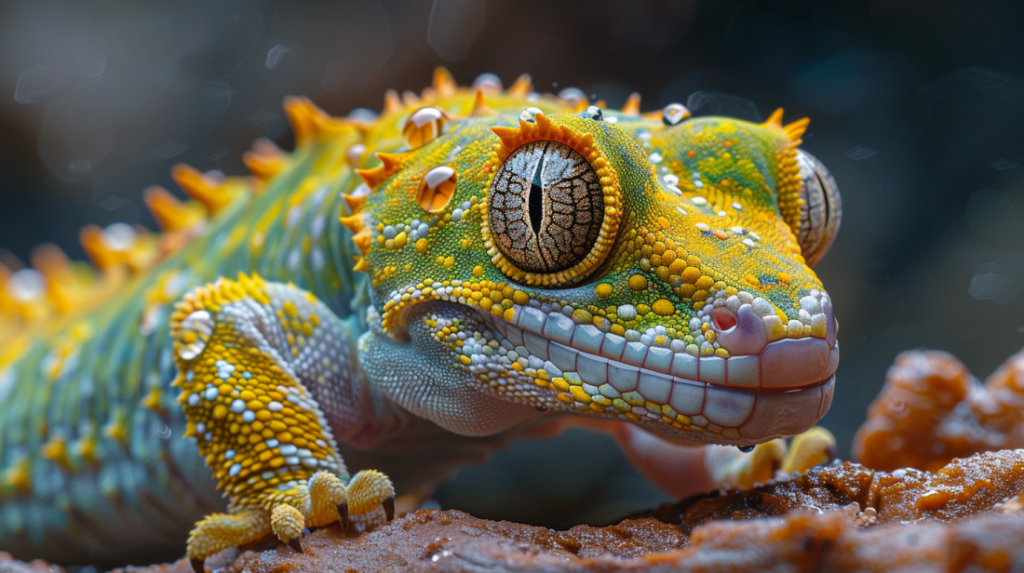
Hornworms (Manduca sexta) contain approximately 9% protein and 3% fat, making them lower in both macronutrients than most other feeders. However, their high water content (approximately 85%) makes them excellent for hydration, particularly beneficial during hot weather or for geckos showing signs of dehydration.
The soft body and high water content make hornworms extremely easy to digest. They’re particularly useful for sick geckos or those with digestive sensitivities. The lower protein and fat content means they should be combined with more nutritionally dense options.
Hornworms grow rapidly and should be used quickly after purchase. Their large size when mature makes them suitable only for adult geckos. The bright green color can be appealing to geckos and may trigger feeding responses in reluctant eaters.
10. Locusts: Natural Prey Simulation
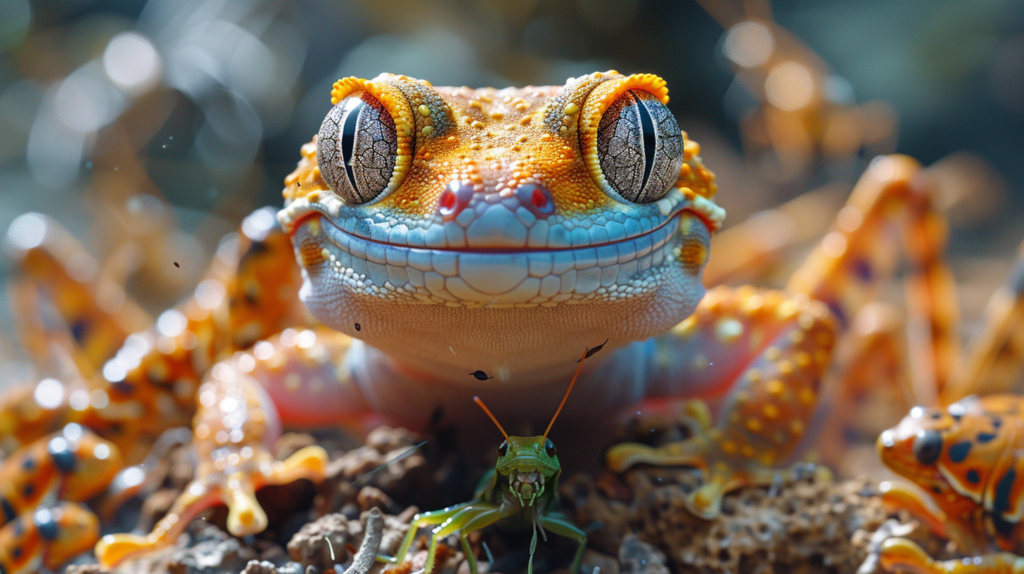
Locusts (Locusta migratoria) provide excellent nutrition with approximately 21% protein and 6% fat. Their active movement and natural behavior closely simulate wild prey, providing mental stimulation and exercise for captive geckos. The protein quality is excellent, with a complete amino acid profile.
The exoskeleton of locusts provides beneficial fiber for digestive health while being soft enough to avoid impaction issues. Their size range makes them suitable for geckos of various ages, though proper sizing remains important. The calcium-to-phosphorus ratio requires supplementation like most other feeders.
Locusts are particularly beneficial for geckos that have become bored with other prey items. Their jumping and flying behavior can reinvigorate hunting instincts and provide enrichment. However, their active nature may make them challenging to contain during feeding.
Feeding Schedule and Portions
Age-Based Feeding Schedules
Establishing proper feeding schedules is crucial for maintaining optimal health throughout your leopard gecko’s life. Juvenile geckos (0-12 months) require daily feeding due to their rapid growth rate and high metabolic demands. During this critical growth period, they should receive 5-7 appropriately sized insects per feeding session.
Adult geckos (12+ months) can be fed every other day or every third day, depending on their activity level, body condition, and environmental temperature. A typical adult feeding consists of 5-7 insects, though this may vary based on the size of the prey items and the gecko’s individual needs.
Senior geckos may require modified feeding schedules based on their activity level and metabolism. Some older geckos benefit from smaller, more frequent meals to ensure adequate nutrition absorption and prevent digestive stress.
Portion Size Guidelines
Determining appropriate portion sizes requires consideration of several factors, including the gecko’s age, size, activity level, and the type of prey being offered. The general rule of thumb is that individual prey items should be no larger than the space between the gecko’s eyes to prevent choking or impaction.
For juvenile geckos, 5-7 small insects (such as small crickets or mini mealworms) per feeding session typically provides adequate nutrition. Adult geckos may require 5-7 medium-sized insects or 3-4 larger insects like superworms. Monitor your gecko’s body condition and adjust portions accordingly.
Breeding females require increased portions, particularly during egg development and laying periods. They may need daily feeding with larger portions to support the energy demands of reproduction. Monitor their body condition closely and adjust feeding frequency as needed.
Supplementation and Gut-Loading
Essential Supplements
Calcium supplementation represents the most critical aspect of leopard gecko nutrition. Pure calcium carbonate powder should be used to dust insects before feeding, with frequency depending on the gecko’s age and reproductive status. Juveniles require calcium supplementation with every feeding, while adults need it 2-3 times per week.
Vitamin D3 supplementation should be provided 1-2 times per week, as excessive D3 can lead to toxicity. Use calcium with D3 supplements sparingly and never as the sole calcium source. The ratio of calcium-only to calcium-with-D3 feedings should be approximately 3:1.
Multivitamin supplements should be used once every 1-2 weeks to ensure adequate vitamin A, E, and B-complex vitamins. Over-supplementation can be harmful, so follow manufacturer guidelines and monitor your gecko’s health closely.
Gut-Loading Techniques
Gut-loading involves feeding nutritious foods to insects 24-48 hours before offering them to your gecko. This process significantly enhances the nutritional value of the prey items and allows you to customize their nutrient profile. Commercial gut-loading diets provide balanced nutrition and convenience.
Effective gut-loading foods include leafy greens, carrots, sweet potatoes, and commercial cricket feeds. Avoid foods high in goitrogens (like cabbage) or those that may be toxic to reptiles. Maintain proper hydration for gut-loading insects using water crystals or gel to prevent drowning.
The gut-loading period should be 24-48 hours for optimal results. Insects should be removed from gut-loading foods 2-3 hours before feeding to prevent spoilage in the gecko’s digestive system. Fresh gut-loading foods should be replaced every 24 hours to maintain quality.
Common Feeding Mistakes to Avoid
Overfeeding and Obesity
Overfeeding represents one of the most common mistakes in leopard gecko care, leading to obesity and related health issues. Obese geckos may experience reduced lifespan, reproductive problems, and increased susceptibility to various diseases. Monitor your gecko’s body condition regularly and adjust feeding accordingly.
Signs of overfeeding include a rounded belly, fat deposits around the neck and tail base, and reduced activity levels. Healthy geckos should have a slight indentation behind their necks and visible hip bones. If your gecko appears overweight, reduce feeding frequency or portion sizes gradually.
Preventing overfeeding requires consistent monitoring and record-keeping. Track feeding dates, amounts, and your gecko’s body condition to identify trends and make necessary adjustments. Regular weighing can help detect gradual weight changes that might not be visually apparent.
Inappropriate Prey Size
Feeding insects that are too large can lead to choking, impaction, or digestive stress. The “space between the eyes” rule provides a reliable guideline for maximum prey size. Err on the side of caution when selecting prey sizes, particularly for juvenile geckos.
Insects that are too small may not provide adequate nutrition or mental stimulation. Adult geckos fed only small insects may not receive sufficient calories or may become bored with their diet. Balance prey size with nutritional needs and natural behaviors.
Consider the length and width of prey items, not just their overall size. Long, thin insects may be more challenging to consume than shorter, rounder alternatives of similar mass. Observe your gecko during feeding to ensure they can handle the prey items comfortably.
Inadequate Supplementation
Failing to provide adequate calcium supplementation can lead to metabolic bone disease, a serious condition that can be fatal if left untreated. Symptoms include weakness, tremors, difficulty walking, and bone deformities. Prevention through proper supplementation is far more effective than treatment.
Over-supplementation can also cause health issues, particularly with fat-soluble vitamins and vitamin D3. Follow manufacturer guidelines and adjust supplementation based on your gecko’s age, reproductive status, and overall health. Regular veterinary check-ups can help identify supplementation issues early.
Inconsistent supplementation patterns can disrupt your gecko’s nutritional balance. Establish a routine and stick to it, making adjustments only when necessary. Keep detailed records of supplementation schedules to ensure consistency.
Creating a Feeding Station
Optimal Feeding Environment
Creating a dedicated feeding area helps establish routine and reduces stress during feeding times. Choose a quiet location away from high-traffic areas to minimize disturbances. Ensure the feeding area has appropriate temperature and humidity levels to maintain your gecko’s comfort.
Use feeding dishes that are shallow and wide enough to prevent insects from escaping while allowing easy access for your gecko. Smooth-sided dishes work well for non-climbing insects like mealworms, while deeper dishes may be necessary for more active prey like crickets.
Consider using feeding tongs or tweezers to offer prey items directly to your gecko. This method allows for better portion control and can help strengthen the bond between you and your pet. However, ensure the tools are clean and appropriately sized to prevent injury.
Monitoring and Record-Keeping
Maintaining detailed feeding records helps track your gecko’s health and identify potential issues early. Record feeding dates, prey types, quantities, and any observations about your gecko’s behavior or appetite. This information is valuable for veterinary consultations and long-term health management.
Monitor your gecko’s weight regularly using a digital scale accurate to at least 1 gram. Weekly weigh-ins provide early detection of weight changes that might indicate health issues. Record weights along with feeding information to identify correlations.
Observe your gecko’s feeding behavior, including hunting enthusiasm, consumption time, and any food preferences. Changes in feeding behavior can indicate health issues, stress, or environmental problems that require attention.
Seasonal Feeding Adjustments
Temperature-Related Changes
Leopard geckos are ectothermic animals whose metabolism and appetite are directly influenced by environmental temperatures. During cooler months, their metabolic rate decreases, leading to reduced appetite and lower feeding requirements. Adjust feeding frequency and portions accordingly to prevent overfeeding.
Warmer temperatures increase metabolic rates and may require increased feeding frequency or portion sizes. Monitor your gecko’s body condition and activity levels to determine appropriate adjustments. Maintain proper temperature gradients in the habitat to support healthy digestion.
Seasonal temperature fluctuations can trigger natural behaviors like brumation (a form of hibernation) in some geckos. During these periods, appetite may decrease significantly or stop entirely. Respect these natural cycles while monitoring for signs of illness.
Breeding Season Nutrition
Female leopard geckos require increased nutrition during breeding season to support egg development and laying. Increase feeding frequency to daily or every other day, and provide additional calcium supplementation. Monitor body condition closely to ensure adequate nutrition without overfeeding.
Breeding males may also require adjusted nutrition to support increased activity and mating behaviors. However, their nutritional needs typically increase less dramatically than females. Maintain regular feeding schedules while monitoring for changes in appetite or behavior.
Post-breeding nutrition is crucial for females to recover from the energy demands of egg production. Continue enhanced feeding schedules until body condition returns to normal. Some females may require extended recovery periods between breeding cycles.
Troubleshooting Feeding Problems
Appetite Loss and Feeding Refusal
Appetite loss can result from various factors, including environmental stress, illness, temperature fluctuations, or dietary boredom. Evaluate husbandry conditions first, ensuring proper temperatures, humidity, and lighting. Address any environmental issues before considering dietary changes.
Offering different prey items can help stimulate appetite in reluctant feeders. Try varying the size, type, or movement of prey items to trigger feeding responses. Waxworms or butterworms are particularly effective for encouraging appetite due to their high palatability.
If appetite loss persists for more than a week, consult with a reptile veterinarian. Underlying health issues may require professional diagnosis and treatment. Early intervention typically results in better outcomes and faster recovery.
Digestive Issues
Digestive problems can manifest as regurgitation, constipation, or unusual bowel movements. These issues may result from inappropriate prey size, inadequate temperatures, or underlying health conditions. Maintain proper habitat temperatures to support healthy digestion.
Impaction, caused by consuming inappropriate substrate or oversized prey, requires immediate attention. Symptoms include lack of bowel movements, lethargy, and loss of appetite. Prevent impaction by using appropriate substrates and properly sized prey items.
Hydration plays a crucial role in digestive health. Ensure your gecko has access to fresh water and consider offering prey items with higher water content if dehydration is suspected. Maintain proper humidity levels to support overall health.
Advanced Feeding Techniques
Variety and Enrichment
Providing dietary variety not only ensures comprehensive nutrition but also provides mental stimulation and prevents boredom. Rotate between different prey types throughout the week to maintain interest and provide diverse nutritional profiles. This approach more closely mimics natural feeding patterns.
Enrichment feeding techniques, such as hiding prey items or using feeding puzzles, can stimulate natural hunting behaviors and provide exercise. These methods are particularly beneficial for geckos that have become sedentary or show signs of boredom.
Consider seasonal variations in prey availability to mimic natural cycles. This approach can help maintain natural behaviors and prevent dietary monotony. However, ensure that nutritional needs are consistently met regardless of seasonal changes.
Breeding Your Own Feeders
Establishing your own feeder insect colonies can provide economic benefits and ensure consistent prey availability. Cricket and mealworm colonies are relatively easy to maintain and can provide a steady supply of fresh insects. This approach also allows for better control over gut-loading and health management.
Breeding your own feeders requires initial investment in equipment and ongoing maintenance. Consider factors such as space requirements, temperature control, and time commitment before establishing colonies. Start with easier species like crickets or mealworms before attempting more challenging options.
Proper colony management prevents diseases and maintains insect quality. Maintain appropriate temperatures, humidity, and ventilation for optimal breeding conditions. Regular cleaning and monitoring help prevent issues that could affect the entire colony.
Health Monitoring Through Diet
Nutritional Health Indicators
Your leopard gecko’s overall health is closely tied to their nutritional status. Healthy geckos display bright, clear eyes, vibrant skin coloration, and active behavior. Their body weight should remain stable with slight seasonal variations. Regular monitoring of these indicators helps detect nutritional issues early.
Skin shedding patterns can indicate nutritional health. Healthy geckos shed their skin completely in one piece every 4-6 weeks. Incomplete sheds or frequent shedding problems may indicate nutritional deficiencies or environmental issues requiring attention.
Bone density and muscle tone are indicators of calcium and protein adequacy. Healthy geckos should have firm muscle tone and proper bone structure. Signs of metabolic bone disease include weak limbs, tremors, and difficulty walking, requiring immediate veterinary attention.
Veterinary Consultation
Regular veterinary check-ups are essential for maintaining optimal health in leopard geckos. Annual examinations can detect early signs of nutritional deficiencies or health issues before they become serious. Establish a relationship with a reptile-experienced veterinarian in your area.
Bring detailed feeding records to veterinary appointments to help with health assessments. This information assists veterinarians in making informed recommendations about dietary adjustments or health concerns. Accurate records are particularly valuable for diagnosing chronic issues.
Don’t hesitate to consult with a veterinarian if you notice any changes in your gecko’s eating habits, behavior, or appearance. Early intervention typically results in better outcomes and lower treatment costs. Professional guidance is invaluable for maintaining your gecko’s long-term health.
Frequently Asked Questions
How often should I feed my leopard gecko?
Juvenile leopard geckos (0-12 months) should be fed daily due to their rapid growth requirements. Adult geckos can be fed every other day or every third day, depending on their activity level and body condition. Breeding females may require daily feeding to support egg production. Monitor your gecko’s body condition and adjust feeding frequency accordingly.
Can leopard geckos eat fruits or vegetables?
No, leopard geckos are strict insectivores and cannot digest plant matter. Their digestive systems are specifically adapted for processing insects and other arthropods. Feeding fruits or vegetables can cause digestive upset and nutritional imbalances. All nutrition should come from appropriate insect prey and supplements.
What size insects should I feed my leopard gecko?
The general rule is that prey items should be no larger than the space between your gecko’s eyes. For juveniles, this typically means small crickets or mini mealworms. Adults can handle larger prey like adult crickets or regular mealworms. Prey that is too large can cause choking or impaction, while prey that is too small may not provide adequate nutrition.
How do I know if my gecko is getting enough calcium?
Signs of adequate calcium intake include strong bones, proper muscle function, and successful shedding. Calcium deficiency can manifest as weakness, tremors, difficulty walking, or bone deformities (metabolic bone disease). Ensure regular calcium supplementation and monitor for any signs of deficiency. Consult a veterinarian if you notice any concerning symptoms.
What should I do if my leopard gecko refuses to eat?
First, check environmental conditions including temperature, humidity, and lighting. Stress from improper husbandry is a common cause of appetite loss. Try offering different prey items or feeding at different times. If appetite loss persists for more than a week, consult with a reptile veterinarian as underlying health issues may be present.
Are wild-caught insects safe for my leopard gecko?
Wild-caught insects are not recommended due to potential exposure to pesticides, parasites, and diseases. They may also contain inappropriate nutritional profiles or be contaminated with harmful substances. Commercially bred insects are safer, more consistent in nutrition, and can be properly gut-loaded. Stick to reputable feeder insect suppliers for your gecko’s safety.
For more expert pet care tips and product recommendations, visit BlithePet.com — your trusted source for pet wellness.
Conclusion
Providing proper nutrition for your leopard gecko is one of the most important aspects of responsible pet ownership. The ten food for leopard geckos options outlined in this guide offer a comprehensive foundation for meeting your gecko’s nutritional needs throughout their lifetime. From the reliable nutrition of crickets and mealworms to the premium options like dubia roaches and silkworms, each prey item contributes unique benefits to your gecko’s health and well-being.
Remember that successful leopard gecko nutrition extends beyond simply selecting appropriate prey items. Proper supplementation, gut-loading, feeding schedules, and environmental conditions all play crucial roles in maintaining optimal health. Regular monitoring of your gecko’s body condition, behavior, and feeding response helps ensure that their nutritional needs are being met consistently.
The key to long-term success lies in understanding that leopard gecko nutrition is not a one-size-fits-all approach. Individual geckos may have preferences, age-specific needs, or health considerations that require dietary adjustments. By staying informed about proper nutrition principles and maintaining detailed records of your gecko’s health and feeding patterns, you can provide the best possible care for your scaly companion.
As you implement these feeding strategies, remember that patience and consistency are essential. Building healthy feeding routines takes time, and your gecko may need time to adjust to new prey items or feeding schedules. The investment in proper nutrition will pay dividends in your gecko’s health, longevity, and quality of life.
Have a similar experience with your pet? Share it in the comments below!

